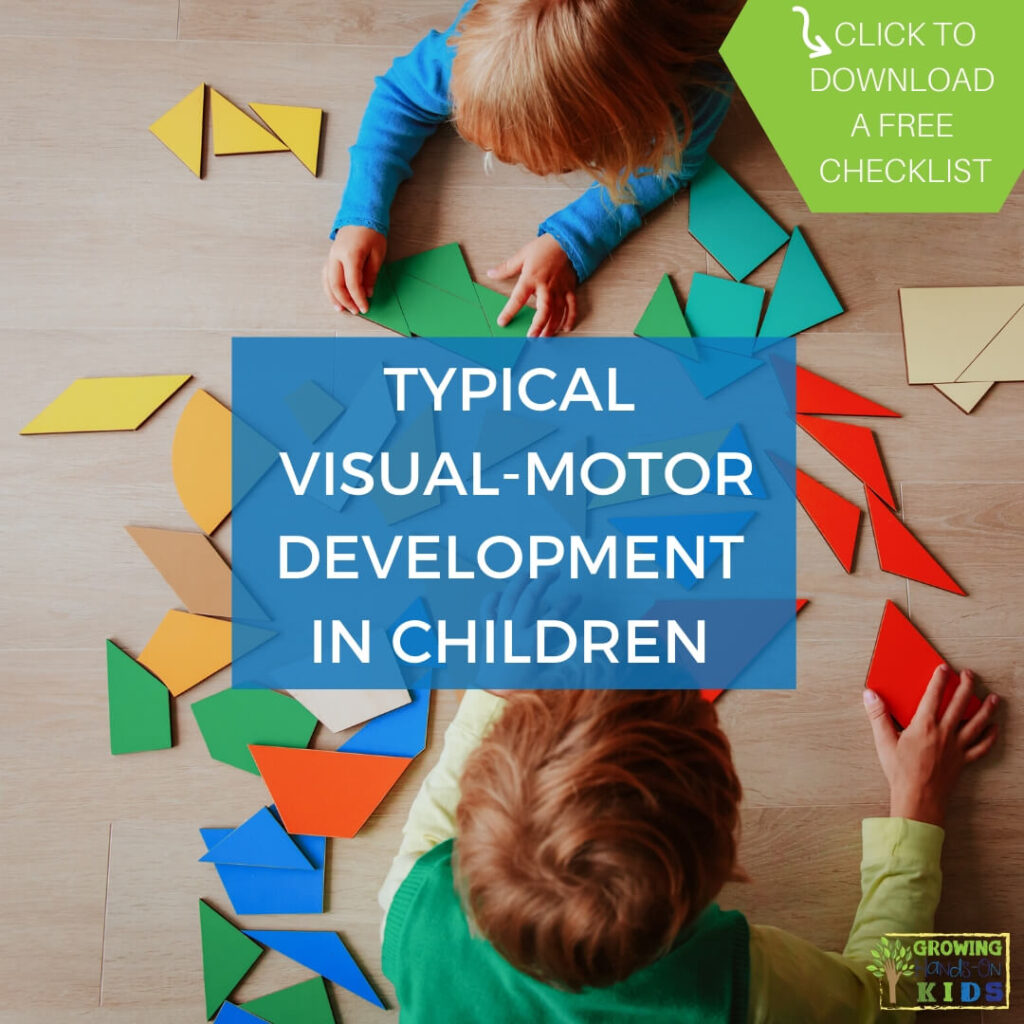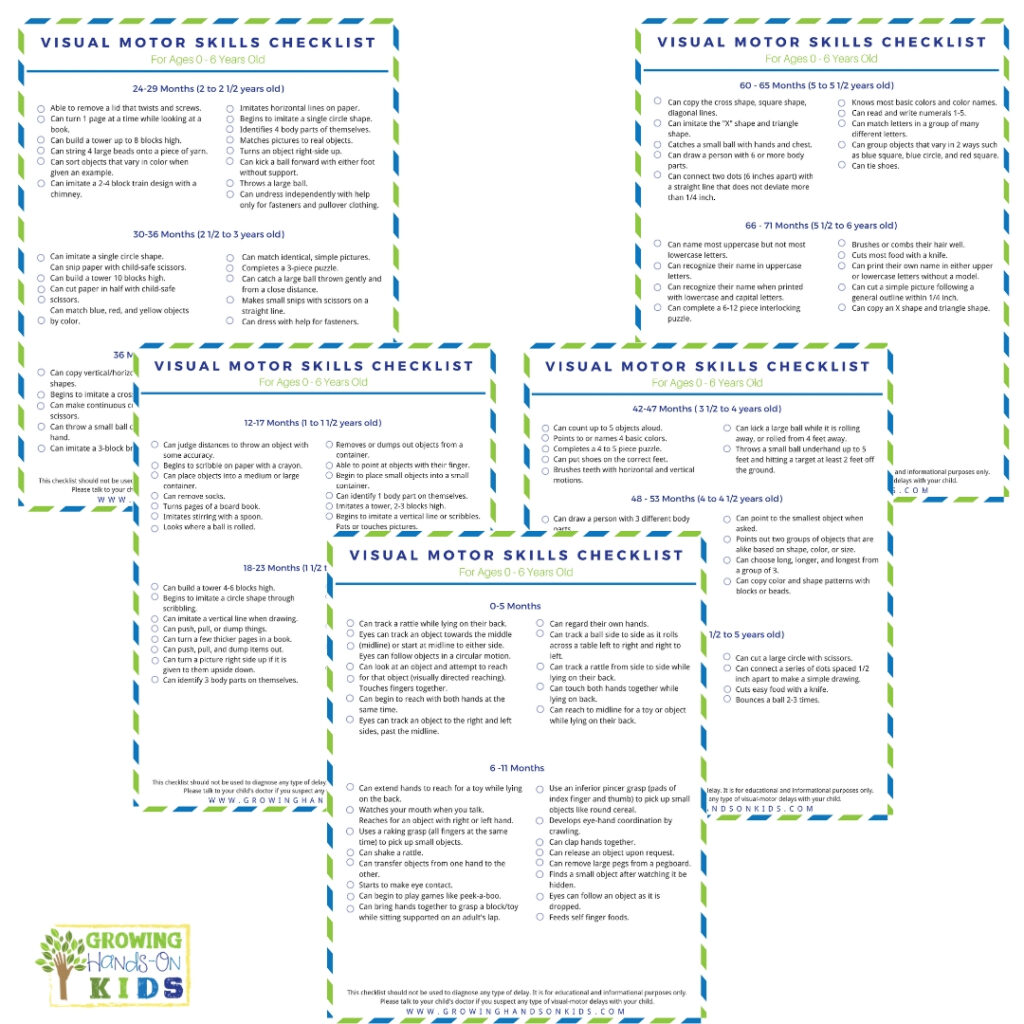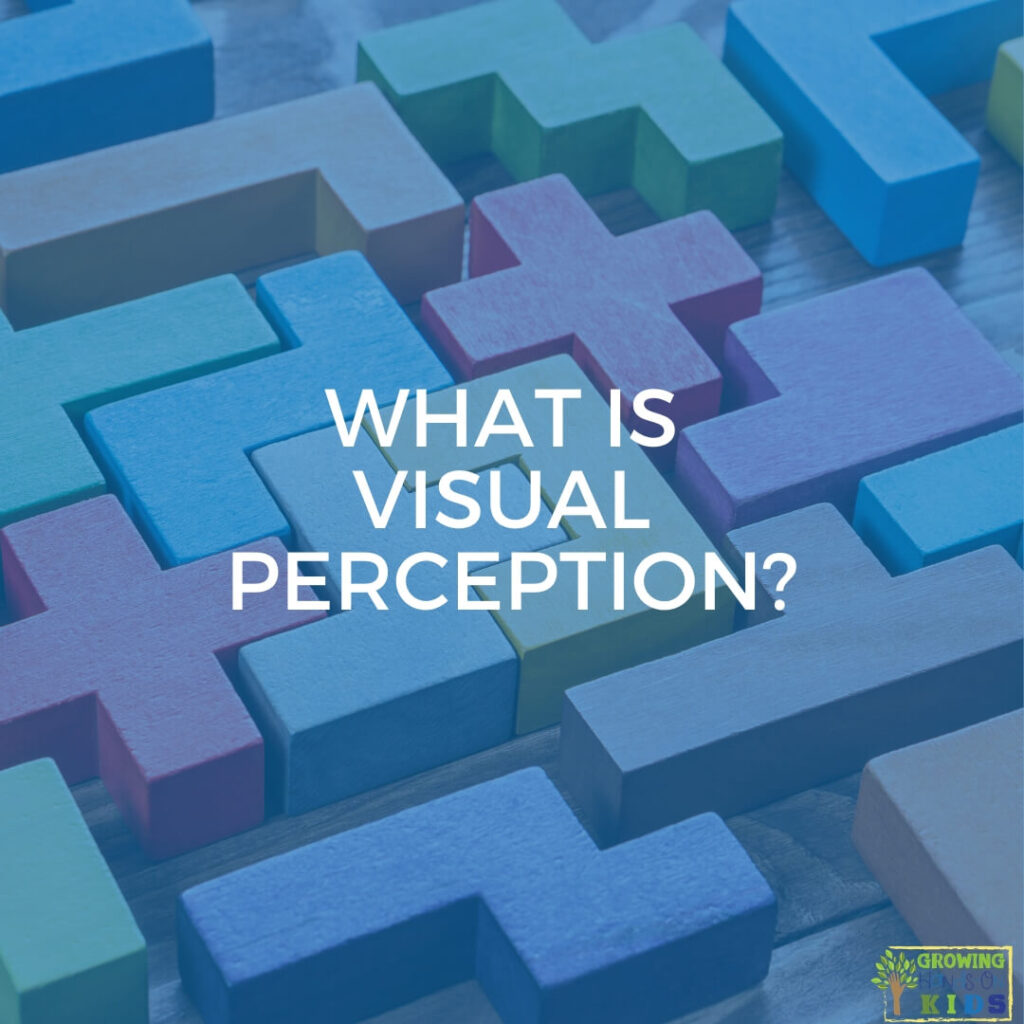Typical Visual Motor Development In Children
Affiliate and Referral links are used below to promote products I love and recommend. I receive a commission on any purchases made through these links. Please see my disclosure policy for more details. As an Amazon Associate, I earn from qualifying purchases.
Watching your child grow and develop new skills is such an exciting journey! One of the key pieces of early development is something called visual-motor skills, the ability to use the eyes and hands together to complete everyday tasks like stacking blocks, drawing, or even buttoning a shirt.
In this post, we’ll walk through what typical visual-motor development looks like from birth through age six. You’ll also find simple, play-based activity ideas you can try at home (or in the classroom!) to help your child build a strong foundation.
And if you love having things in one place, don’t miss the free printable visual-motor development checklist at the end of this post—it’s a handy tool you can download and keep for quick reference.
Typical Visual-Motor Development in Children
For this post, we will be reviewing developmental milestones from ages 0 months to 6 years old. Remember that the ages are given as a range. Some children may master these skills sooner, while others later.
0-5 Months Old
- Tracks a rattle while lying on their back
- Tracks an object towards the middle (midline) or starts at the midline to either side
- Follows objects in a circular motion
- Looks at an object and attempts to reach for that object (visually directed reaching)
- Touches fingers together
- Begins to reach with both hands at the same time
- Tracks an object to the right and left sides, past the midline
- Regards (recognizes) their own hands
- Tracks a ball side to side as it rolls across a table, left to right and right to left
- Tracks a rattle from side to side while lying on their back
- Touches both hands together while lying on their back
- Reaches to midline for a toy or object while lying on their back
6-11 Months Old
- Extends hands to reach for a toy while lying on the back
- Watches your mouth when you talk
- Reaches for an object with the right or left hand
- Uses a raking grasp (all fingers at the same time) to pick up small objects
- Shakes a rattle
- Transfers objects from one hand to the other
- Starts to make eye contact
- Begins to play games like peek-a-boo
- Bring hands together to grasp a block/toy while sitting supported on an adult’s lap
- Uses an inferior pincer grasp (pads of index finger and thumb) to pick up small objects like round cereal
- Develops eye-hand coordination by crawling
- Claps their hands together
- Releases an object upon request
- Removes large pegs from a pegboard
- Finds a small object after watching it be hidden
- Follows an object as it is dropped
- Feeds self finger foods
12-17 Months (1 to 1.5 years old)
- Judges' distance to throw an object with some accuracy
- Scribbles on paper with a crayon
- Places an object into a medium or large container
- Removes socks from their feet
- Turns pages of a board book
- Imitates stirring with a spoon
- Looks where a ball is rolled
- Removes or dumps out objects from a container
- Points at objects with their finger
- Places small objects into a small container
- Identifies 1 body part of themselves
- Imitates a tower, 2-3 blocks high
- Imitates a vertical line or scribbles
- Pats or touches pictures
18-23 Months (1.5 to 2 years old)
- Builds a tower 4-6 blocks high
- Imitates a circle shape through scribbling
- Imitates a vertical line when drawing
- Pushes, pulls, or dumps things
- Turns a few thicker pages in a book
- Turns a picture right side up if it is given to them upside down
- Identifies 3 body parts on themselves
- Matches pictures of items to real objects
- Kicks a ball by walking into it or swinging their leg (they may also miss the ball)
- Throws a small ball a few feet while standing
- Scoops food from one container to another
- Feeds self some food without spilling much
24-29 Months (2 to 2.5 years old)
- Removes a lid that twists and screws
- Turns 1 page at a time while looking at a book
- Builds a tower up to 8 blocks high
- String 4 large beads onto a piece of yarn
- Sorts objects that vary in color when given an example
- Imitates a 2-4 block train design with a chimney
- Imitates horizontal lines on paper and a single circle shape
- Identifies 4 body parts of themselves
- Matches pictures to real objects
- Turns an object right-side up
- Kicks a ball forward with either foot without support
- Throws a large ball.
- Undresses independently with help only for fasteners and pullover clothing
30-36 Months (2.5 to 3 years old)
- Imitates a single-circle shape
- Snips paper with child-safe scissors
- Builds a tower 10 blocks high
- Matches blue, red, and yellow objects by color
- Matches identical, simple pictures
- Completes a 3-piece puzzle
- Catches a large ball thrown gently and from a close distance
- Makes small snips with scissors in a straight line (closer to 3 years old)
- Dresses with the help for fasteners
36 Months – 41 Months (3 to 3.5 years old)
- Copies vertical/horizontal lines, and circle shapes
- Imitates a cross shape
- Makes continuous cuts with child-safety scissors
- Throws a small ball overhand with one hand
- Imitates a 3-block bridge design
- Catches a large ball thrown from 5 feet away
- Sorts circle, square, and triangle shapes when shown how
- Matches items by texture
- Recallsvsome aspects of pictures
- Names an object when only part of it is shown
42-47 Months (3.5 to 4 years old)
- Counts up to 5 objects aloud
- Points to or names 4 basic colors
- Completes a 4 to 5-piece puzzle
- Puts shoes on the correct feet
- Brushes teeth with horizontal and vertical motions
- Kicks a large ball while it is rolling away, or rolls it from 4 feet away
- Throws a small ball underhand up to 5 feet and hits a target at least 2 feet off the ground
48 – 53 Months (4 to 4.5 years old)
- Draws a person with 3 different body parts
- Pedals a tricycle around obstacles and makes U-turns
- Dresses and undresses without much help
- Catches a large ball from 3 feet away
- Points to the smallest object when asked
- Points out two groups of objects that are alike based on shape, color, or size
- Chooses long, longer, and longest from a group of 3
- Copies color and shape patterns with blocks or beads
54 – 59 Months (4.5 to 5 years old)
- Sorts objects by color, size, and shape
- Follows moving objects with their eyes
- Selects big, bigger, and biggest and small, smaller, and smallest in a group of objects
- Copies a cross shape
- Imitates a square shape and left/right diagonal lines
- Cuts a large circle with scissors
- Connects a series of dots spaced 1/2 inch apart to make a simple drawing
- Cuts easy food with a knife
- Bounces a ball 2-3 times
60 – 65 Months (5 to 5.5 years old)
- Copies the cross shape, square shape, and diagonal lines
- Imitates the “X” shape and the triangle shape
- Catches a small ball with hands and chest
- Draws a person with 6 or more body parts
- Connects two dots (6 inches apart) with a straight line that does not deviate more than 1/4 inch
- Knows most basic colors and color names
- Reads and writes numerals 1-5
- Matches letters in a group of many different letters
- Groups objects that vary in 2 ways, such as blue square, blue circle, and red square
- Ties shoes
66 – 71 Months (5.5 to 6 years old)
- Names most uppercase but not most lowercase letters
- Recognizes their name in uppercase letters
- Recognizes their name when printed with lowercase and capital letters
- Completes a 6-12 piece interlocking puzzle
- Brushes or combs their hair well
- Cuts most food with a knife
- Prints their own name in either upper or lowercase letters without a model
- Cuts a simple picture following a general outline within 1/4 inch
- Copies an X shape and a triangle shape
References:
Beery, K.E., Beery, N.A. The Beery-Buktencia Developmental Test of Visual Motor Integration. Minneapolis: MSC Pearson, 2006.
Folio, M. R., Fewell R.R. Peabody Developmental Motor Scales 2nd Edition. Autin: Pro-Ed. 2000.
Stensaas, M.S., OTR/L The Developmental Sequence of Visual-Motor Skills. Super Duper Publications, 2007.
What is Visual-Motor Development?
Visual-motor, in layman's terms, means being able to use visual sense and motor skills together in order to complete a task or activity. You may also see it referred to as visual-motor integration, which means that the eyes and motor movements are working together in an efficient way.
Visual-motor development needs visual perceptual skills and gross motor skills in order to be efficient. These terms may seem confusing, so let me break them down even more for you.
- Visual-Motor Development – Using the eyes and motor movements together in an efficient way to complete a task
- Visual-Motor Integration – Efficient communication between the eyes and the arms or legs in order to complete a task or activity. You may see this called VMI. The Beery-Buktenica Developmental Test of Visual-Motor Integration, or VMI, is also an evaluation tool that Occupational Therapists use to assess a child's visual-motor abilities.
- Visual Perception – Being able to interpret and make sense of what you are seeing.
What Are Visual-Motor Skills?
You will often see eye-hand coordination when searching for visual-motor skills. But there are actually 7 building blocks of visual perception that are needed for the visual information to make sense in the brain.
Those 7 building blocks include:
- Visual discrimination – The ability to distinguish one shape from another and focus on important information while blocking background visual “noise.”
- Visual memory – The ability to remember a specific form when it is removed from your field of vision. The ability to recognize letters or numbers, or objects quickly when you see them again.
- Visual-spatial relationships – The ability to recognize objects that are the same but may be in a different spatial orientation.
- Visual form constancy – The ability to find similar objects that may have differences in size, color, or spatial orientation and be able to match similar objects.
- Visual sequential memory – The ability to recall a sequence of items without looking, from memory.
- Visual figure-ground – The ability to recognize discrete objects that are camouflaged or partially hidden. This skill also includes being able to find something in a busy background.
- Visual closure – The ability to recognize familiar forms that are only partially complete.
You can read more about visual perception skills in this post.
Visual-Motor Skill Problems
Children who struggle with visual-motor skills will often have difficulty in school with tasks such as handwriting, math problems, scissor skills, and even reading.
Some of these challenges could include:
- Not lining up math columns correctly (horizontally or vertically)
- Writing off the page
- Poor spelling
- Poor eye-hand coordination (throwing or catching skills)
- Poor organizational skills
- Slow handwriting speed and illegible handwriting
- Have difficulty following multi-step directions
- Poor reading comprehension
- Confuse similar-looking words or letters
- Reverse numbers or letters when writing
- Make errors when copying from the board
- Difficulty completing puzzles or dot-to-dot pages
- Remembering directions for left and right
- Difficulty understanding spatial concepts like “in,” “out,” “under,” “up,” “down,” etc.
- Remembering the alphabet in sequence.
- Remembering sight words
You will also want to have your child's vision checked to make sure there are no physical vision problems before addressing any visual-motor skill concerns.
If you suspect your child has delays in this area of development, talk to your child’s doctor and ask for an Occupational Therapy evaluation. Occupational therapists can evaluate for any type of visual-motor challenge to see what areas a child may need support with visual processing skills.
Activity Suggestion for Visual-Motor Skills
Here are some very basic activity suggestions to help your child's visual-motor skills:
- Completing mazes or I-Spy activities
- Putting puzzles together
- Ball tossing or kicking activities (especially with a target)
- Scissor activities
- Practicing pre-writing lines and shapes with preschoolers (before introducing handwriting and letter formations)
- Building with blocks (here are some block activity suggestions)
- Beanbag tosses (corn hole game)
- Popping bubbles
Free Visual-Motor Development Checklist Printable
I have the visual-motor development ages and tasks that I posted above in this handy checklist format. It's a free printable on my site when you sign up for my weekly child development newsletter.
If you are new to GHOK, when you sign up to receive the printable below, you'll also be signing up for my free child development weekly newsletter. You'll stay up to date on all the posts from the site, plus access to exclusive free printables and more first. You can unsubscribe at any time.
If you are already a subscriber, don't worry, you won't be subscribing twice. By entering your email address below it lets my printable hosting service know which printable packet to send you.
By downloading this free printable, you are also agreeing to my terms of use and website policies found here.
You May Also Like:

Heather Greutman, COTA
Heather Greutman is a Certified Occupational Therapy Assistant with experience in school-based OT services for preschool through high school. She uses her background to share child development tips, tools, and strategies for parents, educators, and therapists. She is the author of many ebooks including The Basics of Fine Motor Skills, and Basics of Pre-Writing Skills, and co-author of Sensory Processing Explained: A Handbook for Parents and Educators.




Hi There,
I would love to purchase you items but I live in Australia. I am a OT over here and will be working with children in their home settings. Can I pay some way and you can email them? I would love to have acess to your resources.
Kind Regards
Karlye OT in Byron Bay New south Wales Australia
Hi Karlye,
All my products are digital downloads, so you can purchase and download everything right away, there is no shipping.
I hope that helps.